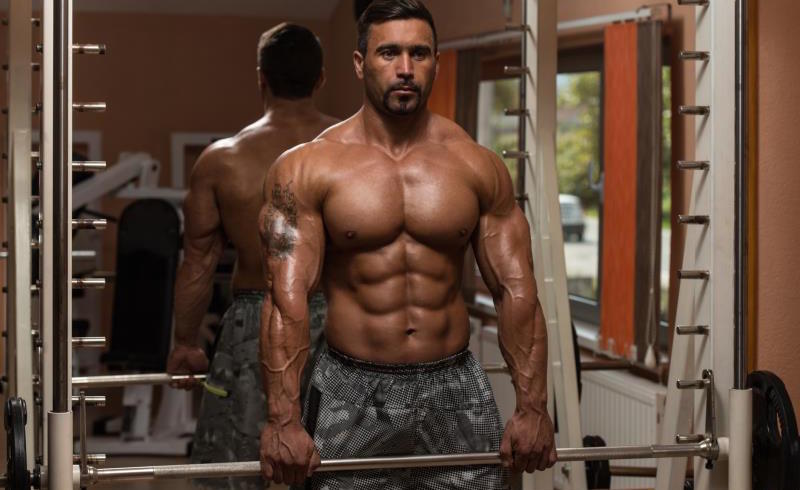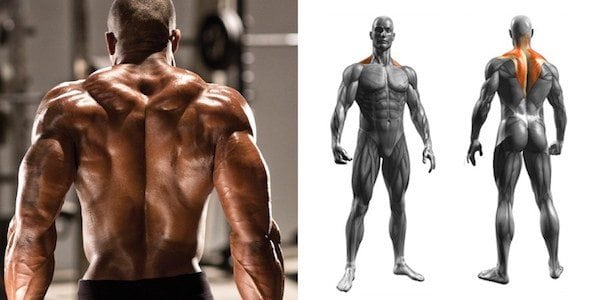No products in the cart.
Tips To Get Huge Traps : Best Exercises For Traps

Most people seem to be of the opinion that the trapezius muscle is located along the upper back, covering the scapula.
This is true, but that is only part of the trapezius muscle. There is an upper, middle, and lower part – it’s just that the middle and lower parts are not visible.
In terms of muscle size, your traps are as big as your chest muscles and just as important for overall strength and size. But do you know anyone who trains their traps as much as their chest? What about anyone who trains them more?
According to Testosterone Nation [1], you really should be training your trapezius muscles as much as your chest, if not more.
Due to the muscles being mostly made up of slow-twitch muscle fibres it would make sense to go high volume. Lots of sets and reps!
Of course, when training for hypertrophy it is best to train across different rep ranges. So don’t be afraid to mix it up.[toc]
What Are Your Traps And Why Are They Important?
The trapezius muscle is separated into 3 parts. Known as the upper strands, the centre strands, and the lower strands. The reason for this division lies in the variety of tasks performed by this muscle.
The trapezius muscle is vital for various movements, including moving the shoulder bone in at the spine; pivoting the shoulder bone so that the highest part of the upper arm faces up; moving the shoulder bone back and forth; moving the head and neck downward; turning and twisting the neck, and aiding in relaxing and resting.
As you can see, these are incredibly important functions that we need to occur. So it makes sense that you want them to work appropriately, especially if you’re involved in bodybuilding.
Why Is Strengthening The Trapezius Muscles Important?
There are 2 main reasons; the first is that it’s a vital muscle group which offers support to your whole upper body.
The second reason is that when properly developed the trapezius is one of the most powerful muscles in your body. This is one of the reasons training and machines for your traps are so popular in most gyms around the world.
Best Exercises For Huge Traps
The obvious exercise to build massive traps is the shrug, there are a couple of variations:
- The barbell shrug where you hold a bar in front of your legs.
- Or the dumbbell version where you are holding the weights using a neutral grip by your side.
The shrug, both with a straight bar and with dumbbells, permits you to prepare the trapezius along its characteristic plane of movement and with negligible support from the deltoids.
Dumbbells allow you to position your hands comfortably and they can help you from putting any undue stress on the shoulder (G/H) joint.
For beginner lifters, the dumbbell version is definitely superior, but for stronger lifters, the barbell might be better as you can place heavier weights on the bar.
The straight bar shrug causes more outer turn at the G/H joint, bringing about more stretch on the rotator cuff.
You should bend a little to minimise the drag of the dumbbells on your thighs as you shrug the weight up.
It is also recommended that you also keep your elbows somewhat curved, but at the same angle throughout each rep.
Keep in mind that the right technique includes shrugging the shoulder up as though to indicate to someone else that you are unsure of something. That’s why it’s called the shrug – it imitates the motion of “shrugging.”
Hold the position for a moment and release, gradually bringing down the dumbbells to a totally extended position.
Your head should stay tilted slightly, but make sure that it is not resting on your chest.
You should refrain from tossing the head back or utilising any unnecessary movement, as this can result in harm to your neck.
You should also refrain from turning the shoulders too aggressively, as a lot of people try to do, as this does literally nothing to construct your traps.
Four to six sets of ten reps with substantial dumbbells will do the trick! Try this for yourself and see how it works for you.
Another good exercise choice would be the upright row.
For some reason, this exercise has become known as a high-risk exercise that should be avoided. The truth is that when performed correctly an upright row is perfectly safe.
The upright row hits the deltoids as the arms go up, with the trapezius working to stabilise you. It is not, in this manner, an exercise that solely focuses on the trapezius.
Poor form on the upright row can bring about damage to the rotator cuff.
In the event that you strain your arms too far (by pulling too far upward), the acromioclavicular joint will encroach on the rotator cuff. This can result in unnecessary wear and tear and can cause severe injury.
Small changes such as using dumbbells instead of a bar, can reduce the risk further.
Making sure not to pull the dumbbells too high is another tip.
Performing a face pull using a cable rope attachment is an excellent trap builder, particularly if you lower the height slightly (compared to the traditional exercise).
Use a medium to light weight and try to prevent yourself from rocking back and forth whilst pulling the rope towards you.
You don’t always have to be targeting the traps specifically to get a good workout for them, a lot of upper back exercises can utilise the traps as a secondary muscle.
Barbell bent-over rows, single-arm dumbbell rows, T-Bar Rows, and pendlay rows are really good for engaging the traps.
Deadlifts are another exercise that will work them (as you need them to maintain proper posture while lifting).
Pull-ups can also strengthen traps so don’t forget to add them into your routine as well.
Ultimate Trap Workout

In this section we will create a trap workout for you to follow, using all of the exercises that we mentioned above.
This workout will be a back and trap workout, as so many of the exercises work both.
- Face Pulls: 3 x 12-15
- Inverted Row: 3 x 12
- Rack Pulls: 4 x 6
- Seated Low Row: 3 x 12
- Single-Arm Dumbbell Row: 3 x 10 (each)
- Dumbbell Shrugs: 4 x 15
- Dumbbell Upright Rows: 3 x 12
As you are training for strength and hypertrophy rather than for fat burning purposes, you can have slightly longer rest periods between sets.
Try to aim for around 3 minutes rest. This will allow you to fully recover from the previous set and to train at a higher intensity in the next set.
Obviously smaller exercises such as the face pulls can use shorter rest periods. Time them all to prevent you from under/ overdoing it.
Final Thoughts
Training your traps is a great way to improve your posture, increase your upper body strength, improve your physique, and it can also improve certain exercises such as barbell squats.
You shouldn’t always be concentrating on mirror muscles such as the chest or lats. The less fashionable muscles need love and attention too!
Try to hit your traps at least twice per week, even if it’s just a couple of exercises max. You can train them as part of a shoulder workout, part of a back workout, an upper body workout, or a full-body workout. Just find the one that suits your current training program best.
Deadlifts and rack pulls are excellent exercises in their own right, and they will also help strengthen your traps, so add them in too.
Just try and be as consistent as possible and pay attention to your form throughout.
You’ll be shocked at how improved your back will look once you start dedicating time on your traps.
Remember, to pack on lean muscle you must eat correctly or you will have problems.
There are a number of different foods that you can eat that will help you bulk up. If you know how to eat right ahead of time, you will be better able to push yourself to your limits.
Save
